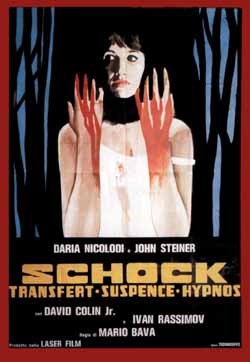|

Italian poster artwork for
Schock (Transfer-Suspence-Hypnos)
(American title: "Beyond the Door II").
Beyond the Door II (1977)
D: Mario Bava. (aka Schock (Transfert-Suspence-Hypnos); All 33 di Via Orologio fa sempre freddo)
The misleading title does a disservice to this scary, original shocker, Bava's final feature film. Daria Nicolodi gives a top-notch performance as a woman who descends into madness when she moves back to the scene of her first husband Carlo's "suicide" with her new spouse (John Steiner). Strange things start happening, mostly involving her son Marco, who seems to be possessed by Carlo's spirit. Soon, however, it becomes clear that Nicolodi is becoming completely unhinged. The script (by Lamberto Bava, Francesco Barbieri, Paola Briganti and Dardano Sacchetti) handles Nicolodi's shifting sense of reality with great skill and a subtlety rare for Italian horror films of the period. Bava includes some effective hallucination scenes and the usual vaguely incestuous subtexts to keep things interesting., and there's a cheap but effective "gotcha" scene that will send viewers out of their seats.
Cannibal Holocaust (1979)
D: Ruggero Deodato.
Umberto Lenzi began the cycle of brutal Amazonian-set cannibal horrors with 1972's Man from Deep River ("Il Paese del Sesso Selvaggio") and effectively ended it with 1980's nauseating Make Them Die Slowly ("Cannibal Ferox"), but Deodato made the subgenre's most enduring film. This popular bloodbath features a fetus ripped from a woman's body, people fed to piranhas and impaled on spikes, a mondo-style tortoise-flaying, and all manner of indignities large and small. The gimmick here is a group of American explorers trying to find out what happened to a missing documentary film crew. They receive a scratchy film reel of the bloody truth from a tribe of tree-dwelling natives, allowing Deodato to cover up for poor effects quality. Ads claimed that "the crew who filmed it were actually devoured alive by cannibals!"
Other notable cannibal films: Sergio Martino's Slave of the Cannibal God ("La Montagna del Dio Cannibale") (1978) and Umberto Lenzi's The Emerald Jungle ("Mangiati Vivi") (1979). The genre's most peculiar hybrid was Aristide Massaccesi's Trap Them and Kill Them ("Emanuelle e gli Ultimi Cannibali") (1977), which put Laura Gemser's sexy reporter Emanuelle in cannibal country to be worshipped as a goddess. Deodato himself previously made Cannibal! ("Ultimo Mondo Cannibale") (1977), and returned to the theme with Cut and Run ("Inferno in Diretta") (1986), incorporating flesh-eating and gore with a standard action storyline involving drug-smugglers.

Typical mayhem from Cannibal Holocaust.
Zombie (1979)
D: Lucio Fulci. (aka Zombie 2: The Dead Are Among Us; Zombie Flesh Eaters; Island of the Living Dead; Zombi 2.
An audacious gore spectacle from the late maestro of splatter, Lucio Fulci. Tisa Farrow and some other vacationing knuckleheads travel to an island where mad doctor Richard Johnson is trying to reanimate the dead. He experiments with the natives, but everything gets out of hand as Spanish conquistadors come tearing up from the ground hungry for blood and guts. The nauseating set-pieces (created by FX guru Gianetto de Rossi) include a close-up of a woman's eye being pierced by a large shard of wood and a zombie fighting a Great White shark underwater. This relatively well-made shocker was timed to capitalize on the success of George Romero's Dawn of the Dead, which was partially financed by Dario Argento and released in Italy as Zombi. This unofficial sequel was enormously popular worldwide and led to the zombie-gore film becoming the dominant motif of 1980s Italian horror. Fulci returned to the gut-chewing zombie theme himself on numerous occasions, including The Gates of Hell/Twilight of the Dead ("Paura nella Citta dei Morti-Viventi") (1980), House By the Cemetery ("Quella Villa Accanto nel Cimitero") (1981), The Beyond/7 Doors of Death ("L'Aldila") (1981), and Zombie 3 (1988), where he was replaced due to illness by Bruno Mattei (aka Vincent Dawn). Mattei had previously made the popular Night of the Zombies/Zombie Creeping Flesh ("Virus"/"L'Inferno dei Morti-Viventi") (1981).
Other notable zombie films: Aristide Massaccesi's The Grim Reaper ("Anthropophagous") (1980), Antonio Margheriti's Cannibal Apocalypse ("Apocalisse Domani") (1980), Umberto Lenzi's City of the Walking Dead/Nightmare City ("Incubo sulla Citta Contaminata") (1980), Andrea Bianchi's Burial Ground ("Zombi 3") (1981), Claudo Fragasso's Afterdeath (1989) and, most recently, Michele Soavi's wonderful zombie fantasy Cemetery Man ("Dellamorte, Dellamore") (1991). Predating the cycle were a pair of hardcore porno films by Massaccesi: Porno Holocaust and Erotic Nights of the Living Dead ("Le Notti Erotiche dei Morti-Viventi") (both 1975). The former concerns a cannibalistic mutant created by atomic radiation, while the latter deals with more traditional voodoo-type zombies and anticipates Fulci's film in both style and substance.
page 2 of 2
 
Robert Firsching is the founder of the genre film review Web site "AWCM: The Amazing World of Cult Movies." He lives in Northern
Virginia with his wife Anita and is currently working on a book about genre cinema in the video age.
Italian Horror Menu page
Italian Horror: A Brief Introduction
Mario Bava: The Illusion of Reality
Mario Bava's Rabid Dogs
Mario Bava Biography
The Horrible Dr. Hichcock
The Devil's Commandment 
Castle of Blood 
Nightmare Castle
The Bloody Pit of Horror 
Italian Horror in the Seventies
Suspiria
Italian Horror Web Links
© 1997 Robert Firsching
Photo credits: HBO Home Video and Media Home Entertainment
| 




